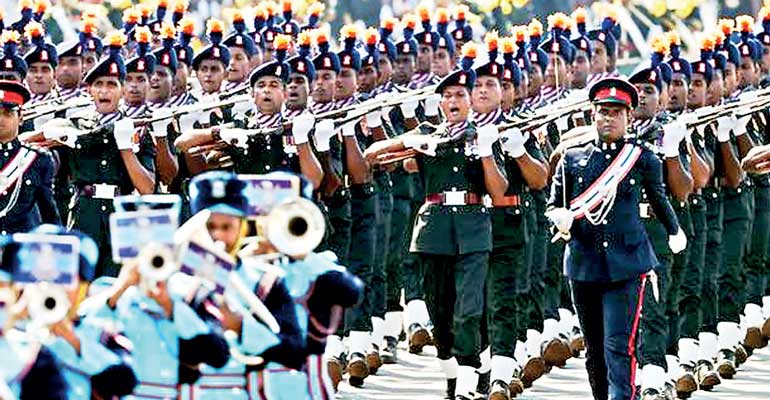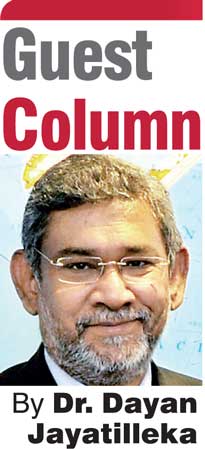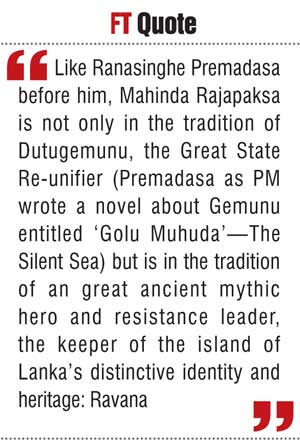Friday Mar 14, 2025
Friday Mar 14, 2025
Monday, 5 February 2018 00:00 - - {{hitsCtrl.values.hits}}

Troops seen marching in formation at Sri Lanka’s 70th Independence Day celebrations - AFP
As the country celebrates 70 years of Independence, Sri Lanka stands at the crossroads. We have a choice of two trajectories: that of furthering our Independence, sovereignty, territorial integrity and self-determination or retreating from it.
Where one road is taking us was made clear yesterday. The leader of the TNA, appointed by the Government as the official Leader of the Opposition, declared his abstention from Sri Lanka’s 70th Independence Day celebrations, thereby using his undeserved, illegitimate, Government-gifted official status to send a quasi-separatist signal to the world.
In 2015 the Yahapalana dispensation installed the so-called Tamil National Alliance (TNA), a regional party with 16 seats, as the Parliamentary Opposition, bypassing Mahinda Rajapaksa and his 50 plus MPs.

The choice of a chief guest at our independence celebrations was symbolic. The members of the British Royalty who were invited to grace the occasion are a nice enough couple, but utterly inappropriate for the occasion itself. We were celebrating our Independence from Britain, the colonial power which occupied and oppressed us for a century and a half. If not for World War 2, the weakening of colonialism and the rise of the USSR as the main power that defeated fascism, the world would not have been able to shake off colonial rule. It was a great betrayal of our martyrs and heroes of the anti-colonial resistance wars, Keppitipola and Puran Appu, to invite British Royalty to be chief guests at our Independence celebrations.
The British had to bring troops in from India to suppress the 1848 rebellion led by Puran Appu. The post-rebellion repression was so brutal, severe and quasi-genocidal (in today’s parlance) that a progressive Irish journalist who was in Ceylon petitioned the British parliament for two years and (as noted by Karl Marx himself) it came up in Westminster in 1850.
The presence of the British Royalty on 4 February this year was an insult to the memory of the martyrs of 1848 and even the progressive Irishman who campaigned for us in London in 1848-1850.
As proudly disclosed by Prime Minister Wickremesinghe in an after-dinner speech in 2015, it was at the intimation of UK High Commissioner James Dauris that he, Mr. Wickremesinghe, who instructed that Sri Lanka uncritically co-sponsor the UK-US sponsored Geneva resolution of October 2015. This was an Anglo-American ‘Atlanticist’ move, with the former colonial power as the driving force. The 2015 Resolution was the embryo of a Balfour Declaration, this time made to the Tamil Diaspora voters in Britain. Its early precursor was the accord drafted by British Cabinet Minister Liam Fox and signed by President Chandrika Kumaratunga and Opposition Leader Ranil Wickremesinghe in 1997.
By accepting, welcoming and basing itself on the unprecedented OISL report of the UN High Commissioner for Human Rights, the 2015 Geneva resolution was a falsification of the history of our victorious and just Great Patriotic War.
The special courts that are to be set up for corruption ‘show trials’ resulting in the possible removal of Mahinda’s civil rights are but a camouflaged method of establishing the special courts that were promised in the 2015 Geneva resolution for war crimes trials.
Already in 1948, the Ceylonese Left which had militantly agitated for independence was raising questions as to whether the Independence we had obtained was authentic - so supinely imitative was the conduct of the UNP which took over.
Some on the Left did more than agitate. Harry Abeygunawardena, the father of Asoka Abeygunawardena, an advisor to President Sirisena, presided over the 3rd Congress of the Communist Party of Ceylon in the southern township of Athureliya in 1948, adopted a resolution that described Independence obtained that year as fake, and called for armed rebellion. In furtherance of that call, he and a detachment of Communists militants, shotguns in hand, laid siege to and occupied a large estate. That revolutionary activism was abandoned at the 4th Congress of the Communist Party in 1950 in Matara, at which the slogan of a broad anti-imperialist, anti-UNP front which included the nationalistic sections of the bourgeoisie, was adopted.\
Incomplete Independence
The idea that our Independence was incomplete remained in the political consciousness and went mainstream. The MEP’s ‘Silent Revolution’ of 1956 was seen as a completion of Independence and a struggle which should have but did not take place in 1948; a belated fulfilment of Independence.
S.W.R.D. Bandaranaike called for the nationalisation of British-owned tea plantations, the removal of British Air Force and Naval bases including from Trincomalee. Some parts of the manifesto were implemented but others had to await the victory of the United Front in 1970. The peak of achievement was the rupture from the Soulbury Constitution and more pointedly the British Crown, with the promulgation of the First Republican Constitution of May 1972. But now, the old UNP mentality is reincarnated in Prime Minister Ranil Wickremesinghe, and so is the British Royalty, on Sri Lanka’s Independence Day of all days.
Prime Minister Wickremesinghe said at a recent election rally that his government is trying to install the “European model” – what he said is also translatable as “a system as in Europe”. Now, every politically literate person knows that the European system is in crisis, which is why the UK is escaping from it, why the pro-Russian, pro-Chinese, populist candidate won the recent Czech Presidential election, and why the very civilisational fount of Europe, Greece is sinking not due to its own fault but the impositions from the European hegemonic model. Every rational person also knows that Sri Lanka is in the global South in general, and in Asia in particular, which makes the European model incapable of sustainable transfer and taking root, and also that there are far more feasible, successful and newer models closer at hand. The PM has frankly laid out his plans for Sri Lanka 70 years after Independence. It is we the citizens who do not seem to connect the dots and see the shape of the future the UNP offers us. India is to be given footholds in KKS, Trincomalee, Mannar, Colombo port (Eastern terminal) and Mattala. The same point that India’s Defence Minister Nirmala Sitharaman makes about China’s presence in Hambantota, must surely apply to India’s footholds in Sri Lanka. The Hindu reports: “Whether China will confine itself to only port activities in Hambantota port is a question and I do not want to say anything further,” she has told reporters after a meeting on the implementation on ‘New India vision 2022’ at the Collectorate in Tamil Nadu on Wednesday. Further, she said: “Whether China will use the port only for port activities is a question mark and my reply answers all your queries.” If we apply the Indian Defence Minister’s suspicions about possible dual use (civil/military) by China of its facility in Hambantota to Indian facilities too - as we logically must - it is evident that Prime Minister Wickremesinghe intends to permit India to establish a strategic ring which encircles the island of Sri Lanka, embedded on the soil of the island itself. Which island can retain its Independence with such a ring around it, on its very territory? If this is not a return to the colonial model of suffocating strategic control, then what is?
Furthermore, in our case, one cannot equate a Chinese facility with an Indian one. India is our giant neighbor, China isn’t. China has one episode of coercive interaction with Sri Lanka, while this island’s history has been scarred by many such incursions and occupations from the neighboring power.
Even more pertinently, China doesn’t have a Tamil Nadu within it, while India does, and that Tamil Nadu is separated from us by a mere narrow strip of water. All this is self-evident but Prime Minister Wickremesinghe proposed a land bridge with Tamil Nadu when he was PM in 2001 and renewed the conversation with Minister Nitin Gadkari adding an underwater tunnel to the plan, when he became PM in 2015.

Tamil Nadu-Trincomalee-Vavuniya axis
What is truly scary and reprehensible is that the UNP leader and the country’s Prime Minister Ranil Wickremesinghe knows full well the implications of what he is planning. Speaking at an election rally in Vavuniya last week, he told his audience that “with the rapid development of neighboring Tamil Nadu, the development of the Trincomalee area with Singaporean assistance, will empower the island’s North and East, including Vavuniya”. So he envisages and proposes a Tamil Nadu-Trincomalee-Vavuniya axis. Add to this the envisaged federal or supra-federal constitutional changes (going by MA Sumanthiran’s Jaffna speech) that the UNP envisages after 10 February, and the Budgetary proposals of Mangala Samaraweera which proposes lifting the land ceilings so that foreign companies, including Indian, Tamil Nadu and Tamil Diaspora ones, can buy up land in the North-East, and island-wide, what is the picture that emerges?
With or without federal powers, a North-East with a Tamil Nadu-Trinco axis and an Indian foothold in the port and oil tank farm, will be a de facto Tamil Eelam or a Greater Tamil Nadu, which is the same thing. The North and East will be an Indian enclave, a beachhead on the island in the Indo-US axis against China. The North and East will be easily convertible either into a separate state or annexed to India. Prime Minister Wickremesinghe is thus making three moves, each of which has the most seriously dangerous existential implications imaginable:
He is establishing an Indian sphere of influence in the North East of our small island home
The dagger of the Tamilnadu-Trincomalee-Vavuniya axis poised at the Sinhala heartland of this island will provide a potential platform for Tamil ‘national’ self-determination
The chokehold of Indian enclaves ringing the island (KKS-Trinco-Mannar-Colombo-Mattala) will constrict the exercise of Sri Lanka’s self-determination as a nation, a country, a state.
The utterly unpardonable consequence of the Prime Minister’s enterprise is that the KKS-Trincomalee-Mannar-Mattala Indian holdings—enclaves/fortresses--within this island will mean nothing less than a shift of the Indian defence perimeter and in effect, India’s border, far southwards onto and into this island itself, abolishing the natural separation and distinct identity afforded by the strip of water—the natural moat—surrounding us and making us an island.
Ranil’s strategic, economic and constitutional plan amounts to abolishing our distinctive island character and building a second Hanuman Bridge which affords India a permanent foothold and fortress here. Like Ranasinghe Premadasa before him, Mahinda Rajapaksa is not only in the tradition of Dutugemunu, the Great State Re-unifier (Premadasa as PM wrote a novel about Gemunu entitled ‘Golu Muhuda’—The Silent Sea) but is in the tradition of an great ancient mythic hero and resistance leader, the keeper of the island of Lanka’s distinctive identity and heritage: Ravana.
Continued on Page 14
Continued on Page 13
In the starkest contradistinction, the Prime Minister we have as we celebrate our 70th Independence is a politico-historic reincarnation, so to speak, of the traitor and collaborator Vibheeshana. His policy is a neo-Vibheeshana paradigm. The Ranil road for Sri Lanka 70 years after Independence ends in Sri Lanka losing its Independence. It offers us the status, role, function and mentality of a colony, albeit of India and the US, of which we have never been a possession. The UNP-TNA project, supported by the West and India, for a Westminster-model parliamentary (as distinct from an executive-Presidential) central government, de jure or de facto federal provincial governments in the strategic Northeast periphery, and a neoliberal economic policy which sells off public assets, would hollow-out and weaken the central state and facilitate the ownership and control of this geo-strategically nodal island as a base.
The Ranil Wickremesinghe-Mangala Samaraweera UNP offers a compliant government that will shrink the Lankan state to the extent that such foreign control is feasible and facilitated, while acting as manager and caretaker of the island on behalf of foreign powers for a fat rental fee.
On 10 February, we, the sovereign people, have the power to take back our country, our dignity and our destiny from these arrogant, pompous, neocolonial marionettes.
Discover Kapruka, the leading online shopping platform in Sri Lanka, where you can conveniently send Gifts and Flowers to your loved ones for any event including Valentine ’s Day. Explore a wide range of popular Shopping Categories on Kapruka, including Toys, Groceries, Electronics, Birthday Cakes, Fruits, Chocolates, Flower Bouquets, Clothing, Watches, Lingerie, Gift Sets and Jewellery. Also if you’re interested in selling with Kapruka, Partner Central by Kapruka is the best solution to start with. Moreover, through Kapruka Global Shop, you can also enjoy the convenience of purchasing products from renowned platforms like Amazon and eBay and have them delivered to Sri Lanka.
Discover Kapruka, the leading online shopping platform in Sri Lanka, where you can conveniently send Gifts and Flowers to your loved ones for any event including Valentine ’s Day. Explore a wide range of popular Shopping Categories on Kapruka, including Toys, Groceries, Electronics, Birthday Cakes, Fruits, Chocolates, Flower Bouquets, Clothing, Watches, Lingerie, Gift Sets and Jewellery. Also if you’re interested in selling with Kapruka, Partner Central by Kapruka is the best solution to start with. Moreover, through Kapruka Global Shop, you can also enjoy the convenience of purchasing products from renowned platforms like Amazon and eBay and have them delivered to Sri Lanka.